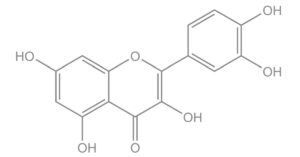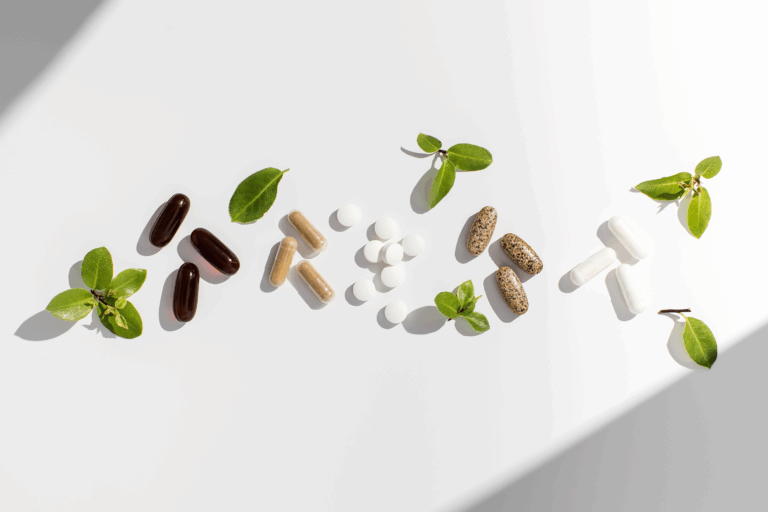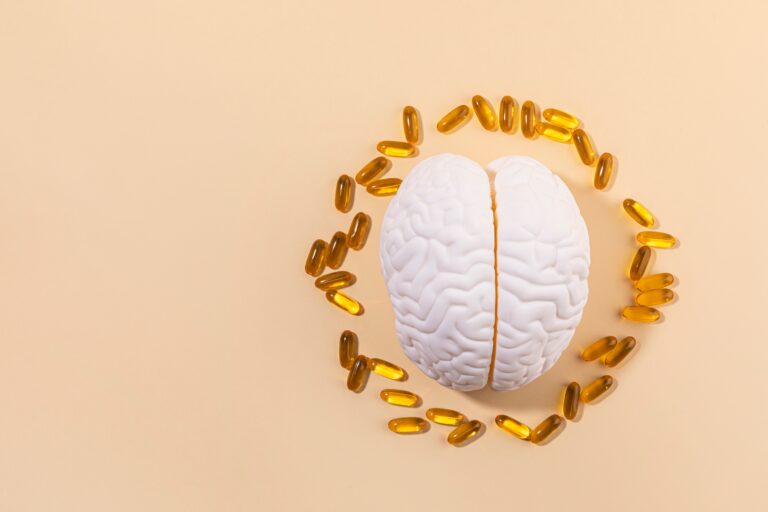Color of Food: Health Benefits of Phytonutrients
The color in fruits and vegetables is more than just aesthetically pleasing; those colors come from phytonutrients in plants. Phytonutrients are secondary metabolites naturally derived from plants that support life and offer protection for the plants but also humans who consume them. They are naturally occurring, naturally pigmented, and found in fruits, vegetables, seeds, nuts, legumes, tea, and dark chocolate.1 In general, phytonutrients are known to possess anti-inflammatory, antioxidant, and anti-cancer activity.2
Health Actions of Phytonutrients
Health-promoting properties of phytonutrients include antibacterial, antifungal, anti-allergic, chemo-preventive, neuroprotective, hypolipidemic, hypotensive, anti-viral, and anti-malarial activity.3,4 Some phytonutrients are also able to support the gut microbiome, selectively inducing the growth of some beneficial bacteria.1 Because phytochemicals from plants are difficult for the body to absorb, it is possible that they spend more time in the intestines and are therefore able to feed bacteria in the gut microbiome.1 Promoting beneficial bacteria in the gut can also lead to benefits beyond the gastrointestinal system, including enhancing the immune system, supporting anti-inflammatory pathways, and maintaining communication along the gut-brain axis.1
Beyond the cellular effects, phytonutrients have been associated with many health benefits including improved body weight, lipid profile, and inflammation, as well as reduced risk of cardiovascular disease, type 2 diabetes, cancer, and mortality.3 Consuming a wider variety of phytonutrients has also been associated with a lower risk of diabetes, cancer, and mortality, and improved cognitive function because of the unique effects of phytonutrients in the body.3,4
Polyphenols

Polyphenols are the biggest class of phytonutrients.1 They are further categorized into flavonoids (the largest group with over 6,000 compounds), flavones, flavanones, isoflavones, flavonols, flavanols, and anthocyanins.1,4,5 In general, polyphenols exert strong anti-inflammatory and antioxidant effects.5
They can also upregulate expression of several enzymes that scavenge reactive oxygen species (ROS), further supporting oxidative balance in cells.5 Polyphenols can also regulate intracellular hormone signaling and gene expression, slow the growth rate of cancer cells, reduce the formation of carcinogenic compounds and DNA damage, and activate insulin receptors.1
Several polyphenols, including catechins and quercetin, also influence the balance between pro- and anti-inflammatory cytokines and modulate inflammation pathways.5
Polyphenols in cancer
Inflammation is a hallmark of both cancer initiation and progression. Because flavonoids are strongly anti-inflammatory, they can reduce cancer progression and demonstrate strong anti-cancer activities.4 The NF-κB signaling pathway is also important in cancer cell signaling because of the inflammatory microenvironment of cancer cells. Polyphenols that target the NF-κB pathway or modulate its expression may be able to inhibit NF-κB and therefore lessen its cancer-promoting effects.6 Examples of phytonutrients that target NF-κB include apigenin in chamomile, curcumin, epigallocatechin-gallate (EGCG) in green tea, genistein in soybeans, quercetin, obovatol from white bark magnolia, resveratrol in grapes, and silymarin found in milk thistle.6
Polyphenols and metabolic health
Epidemiological studies have found that flavonoid-rich diets may prevent some diseases, including metabolic conditions.4 Many flavonoids are able to reduce and modulate inflammation, which is often seen in metabolic diseases.4 The flavonoid quercetin is anti-inflammatory but can also stimulate the expression of glucose transporters which can help maintain healthy blood glucose levels.4 Quercetin consumption may also help lower the risk of developing type 2 diabetes and can enhance glucose-induced insulin secretion.4 Rutin, another flavonoid, may reduce fasting blood glucose, improve glucose tolerance, and reduce serum lipids.4
Polyphenols in neurodegenerative diseases
The study of polyphenols has emerged as a very promising area for both the treatment and prevention of neurodegenerative conditions.5 Polyphenols can preserve neurons and target major mechanisms in pathogenesis including free radical damage, mitochondrial stress, and neuroinflammation.5 Several polyphenols are in phases of clinical trials to assess their efficacy for neurodegenerative diseases, including curcumin, berberine, EGCG, and resveratrol.5 Flavonoids found in blueberries and green tea also work via unique mechanisms to protect the brain.4
Polyphenols for inflammatory conditions
The anti-inflammatory and antioxidant properties of flavonoids make them relevant to nearly any condition that involves inflammation and oxidative stress. Flavonoids can help reduce pain and inflammation in the joints of patients with rheumatoid arthritis, decrease inflammation and oxidative stress in retinal degeneration, and reduce inflammation in inflammatory bowel disease and obstructive pulmonary disorders.4
Carotenoids
Carotenoids belong to the terpenoid class of phytonutrients. They are commonly found in yellow and orange fruits and vegetables, including carrots, tomatoes, and herb. There are over 700 structurally diverse carotenoids.2 Carotenoids are absorbed in the body similar to dietary fat; the presence of fat and cholesterol can enhance their absorption.7
Carotenoids and eye health
Several carotenoids are essential for maintaining healthy eyes and vision. The carotenoids lutein and zeaxanthin exert antioxidant activity that can help reduce damage from oxidative stress in the eye.7 High intake of lutein and zeaxanthin is associated with a reduced risk of cataracts and age-related macular degeneration, a chronic eye condition marked by blind spots and blurred vision.7,8 These carotenoids are enriched in components of the eye, up to 1,000 times higher than other tissues.8
Carotenoids in cancer
Carotenoid intake has been strongly linked to a reduced risk of several types of cancers, including breast and prostate cancers.7 Carotenoids can inhibit cell proliferation, induce cell cycle arrest, and increase apoptosis, all of which can stop or slow the growth of cancer cells.7 Several terpenoids, including lycopene and beta-carotene, are also able to interact with NF-κB and may play a role in cancer development and progression.6,7
Carotenoids in metabolic issues
Increased consumption of carotenoids is linked to a lower risk of developing type 2 diabetes, with possible mechanisms including: regulating the activity of enzymes involved in glycolysis, increasing levels of cellular glucose transporters, and increasing gene expression for insulin receptors.7 Carotenoids also target processes underlying type 2 diabetes, including inflammation and oxidative stress.7
Higher dietary intake of carotenoids also correlates with decreased cardiovascular disease risk.7 Astaxanthin is a particularly potent anti-cardiovascular disease carotenoid because of its antioxidant and anti-inflammatory properties as well as its ability to modulate both lipid and glucose metabolism.7 The carotenoid lutein has been associated with better cardiometabolic health while higher intake of tomato products and lycopene positively affected blood lipids, blood pressure, and endothelial function- important components of cardiovascular health.7
Carotenoids and neurodegeneration
Carotenoids can also help with neurological conditions. Mechanistically, carotenoids promote synaptogenesis, neurogenesis, possess neuroprotective activities, enhance antioxidant defense systems, reduce ROS and inflammatory cytokines, and may promote the clearance of amyloid-beta proteins.7 The concentration of carotenoids is also reduced in neurodegenerative diseases compared to non-neurodegenerative diseases, making it even more important to consume a wide range of carotenoids.7
Glucosinolates
Glucosinolates are sulfur-containing phytonutrients found in cruciferous vegetables such as cabbage, broccoli, and kale.9 Glucosinolates are inactive until they are hydrolyzed by the enzyme myrosinase which converts them to active compounds including isothiocyanates such as sulforaphane.9 Isothiocyanates exert direct antioxidant activity, are able to stimulate phase II enzymes, and possess anti-inflammatory, antimicrobial, neuroprotective, and cardioprotective properties.9 Isothiocyanates and myrosinase can be destroyed by heat, so consuming raw cruciferous vegetables can deliver higher levels of isothiocyanates to the body.9
Health benefits of sulforaphane
In pre-clinical models, sulforaphane improved several markers of metabolic syndrome including obesity, insulin levels, and blood pressure.9 Sulforaphane is able to reduce oxidative stress and inflammation as well as increase levels of glutathione, the most common antioxidant in the body.9 Sulforaphane can also activate cellular defense systems, and it shows promise as an option for both the prevention and treatment of several types of cancer.10
Sulforaphane is being investigated as a potential therapeutic option for Alzheimer’s disease (AD) due to its diverse functions. Sulforaphane prevented cognitive impairment in preclinical models of AD by reducing biomarkers of amyloid-beta protein, tau protein, inflammation, oxidative stress, and neurodegeneration.9 It also improved clinical features of AD including cognition and memory.9
Indole-3-carbinol for cancer, metabolic issues, and inflammation
Indole-3-carbinol (I3C) is an isothiocyanate with broad health benefits in humans. I3C modulates cellular pathways including inflammation, oxidative stress, autophagy, and angiogenesis, as well as major signaling pathways.9 It also possesses chemo-preventive, anti-obesity, anti-diabetic, and cardioprotective effects.9 In pre-clinical models, I3C prevented body weight gain, obesity, and inflammation by modulating pathways involved in adipogenesis, thermogenesis, and inflammation.9
Other Bioactive Plant Compounds
There are many phytonutrients that do not belong to the polyphenol, carotenoid, or glucosinolate families. Alkaloids, such as caffeine and capsaicin, can pass through cell and tissue membranes because of their chemical properties and as such, are an attractive target for therapeutic interventions.5 They are anti-inflammatory, anti-tumor, antioxidant, anti-viral, immunosuppressive, and also support the cardiovascular system.5 Chlorophyll, the green pigment in plants, also has unique benefits for humans, including possible preventing cancer and helping the body balance oxidative stress.11
Human Trials
Phytonutrients are often studied in in vitro models at very high doses, often unachievable in humans.4 However, some human trials have been conducted to evaluate real-world effects of whole-plant extracts on human health. Several phytonutrients have been identified as potential therapeutic targets for various diseases due to their potent anti-inflammatory and antioxidant properties, with multiple progressing to the clinical trial stage.5
Many phytonutrients have also been shown to help with other conditions including sleep, stress, conditions affecting the ear, nose, and throat, digestive health, bone and joint health, physical performance, and cognition.2 While phytonutrients are generally considered safe and well-tolerated, some adverse effects have been reported when consuming large doses of supplemental beta-carotene, astaxanthin, and isothiocyanates.7,9
- Santhiravel, S., Bekhit, A.E.A., Mendis, E., Jacobs, J.L., Dunshea, F.R., Rajapakse, N., Ponnampalam, E.N. (2022). The Impact of Plant Phytochemicals on the Gut Microbiota of Humans for a Balanced Life. Int J Mol Sci, 23:8124.
- Monjotin, N., Amiot, M.J., Fleurentin, J., Morel, J.M., Raynal, S. (2022). Clinical Evidence of the Benefits of Phytonutrients in Human Healthcare. Nutrients, 14:1712.
- Blumfield, M., Mayr, H., De Vlieger, N., Abbott, K., Starck, C., Fayet-Moore, F., Marshall, S. (2022). Should We ‘Eat a Rainbow’? An Umbrella Review of the Health Effects of Colorful Bioactive Pigments in Fruits and Vegetables. Molecules, 27(13):4061.
- Al-Khayri, J.M., Sahana, G.R., Nagella, P., Joseph, B.V., Alessa, F.M., Al-Mssallem, M.Q. (2022). Flavonoids as Potential Anti-Inflammatory Molecules: A Review. Molecules, 27(9):2901.
- Zahedipour, F., Hosseini, S.A., Henney, N.C., Barreto, G.E., Sahebkar, A. (2022). Phytochemicals as inhibitors of tumor necrosis factor alpha and neuroinflammatory responses in neurodegenerative diseases. Neural Regen Res, 17(8):1675.
- Chauhan, A., Islam, A.U.I., Prakash, H., Singh, S. (2022). Phytochemicals targeting NF-κB signaling: Potential anti-cancer interventions. J Pharm Anal, 12(3):394.
- Metibemu, D.S., Ogungbe, I.V. (2022). Carotenoids in Drug Discovery and Medicine: Pathways and Molecular Targets Implicated in Human Diseases. Molecules, 27:6005.
- Eisenhauer, B., Natoli, S., Liew, G., Flood, V.M. (2017). Lutein and Zeaxanthin- Food Sources, Bioavailability and Dietary Variety in Age-Related Macular Degeneration Protection. Nutrients, 9(2):120.
- Kamal, R.M., Razis, A.F.A., Sukri, N.S.M., Perimal, E.K., Ahmad, H., Patrick, R., Djedaini-Pilard, F., Mazzon, E., Rigaud, S. (2022). Beneficial Health Effects of Glucosinolates-Derived Isothiocyanates on Cardiovascular and Neurodegenerative Disease. Molecules, 27:624.
- Mahn, A., Castillo, A. (2021). Potential of Sulforaphane as a Natural Immune System Enhancer: A Review. Molecules, 26:752.
- Hayes, M., Ferruzzi, M.G. (2020). Update on the bioavailability and chemopreventative mechanisms of dietary chlorophyll derivatives. Nutr Res, 81:19.
- Al-Ishaq, R.K., Abotaleb, M., Kubatka, P., Kajo, K., Büsselberg, D. (2019). Flavonoids and their anti-diabetic effects: Cellular mechanisms and effects to improve blood sugar levels. Biomolecules, 9:430.






